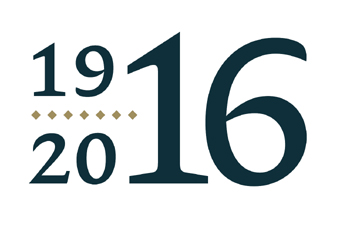Building of the Month - May 2016


The significance of Kilmainham Gaol is as the site of the executions of the 1916 leaders and of imprisonment of many of those involved in the major struggles for independence or reform of the nineteenth and early twentieth century. The only national figures that were not imprisoned here were Daniel O’Connell (1777-1847) and Michael Collins (1890-1922). But because of the importance of that national story it is often forgotten that the prison was built, and primarily served, as a place of confinement for ‘common criminals’.
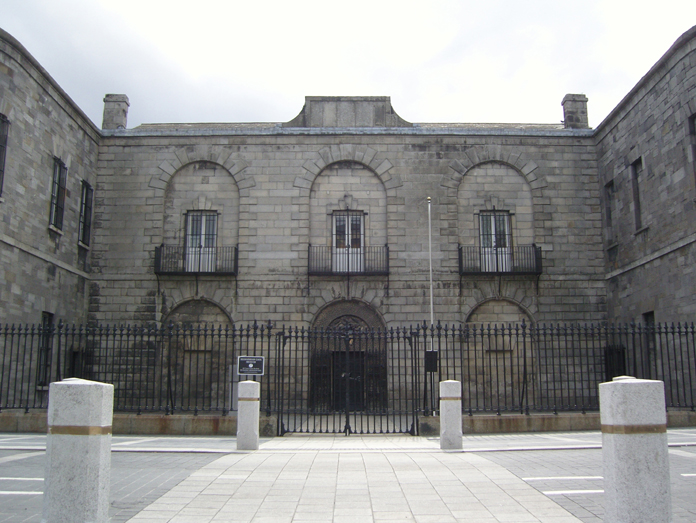
A view of the entrance block of the ‘new Gaol’ designed by Sir John Trail (c.1725-1801) replacing an earlier prison condemned in an Irish Parliamentary Committee report (1782) as ‘extremely insecure, and in an unwholesome bad situation with narrow cells sunk underground [and] with no hospital’. Begun in 1787 and completed in 1796, Kilmainham Gaol came at a cost of £22,000 to the Grand Jury of the County of Dublin. Originally enjoying a countryside setting, and painted so by William Ashford (1746-1824) in “A View of Dublin from Chapelizod” (1795-8), the elevated plot on Gallows Hill was selected to assist the drainage of the site and allow for the circulation of fresh air throughout the prison
The decision to build a new prison at Kilmainham was made by the Dublin Grand Jury in 1786. Prisons were, in the eighteenth century, places of cruelty and squalor. Kilmainham was to be different. Inspired by the ideas of the Enlightenment, the new prison was to be a modern facility where, through a regime of hygiene, separation and work, a prisoner would be reformed to be ‘safely’ released back into society.
.jpg)
An extract from the Ordnance Survey published in 1847 showing the original layout of Kilmainham Gaol with two “U”-shaped wings enclosing courtyards on either side of a central block. The entrance block, which included accommodations for the gaolers, fronts directly on to Kilmainham Road
The original complex, opening in 1796 and built to a design by Sir John Trail (c.1725-1801), was composed of an entrance and administrative block to the north, a central block running north south and, to either side, the cells set around two courtyards. A series of yards, dedicated to specific activities, or types of prisoners, were arranged around the cell blocks. A high limestone wall, with bastions on the four corners, enclosed the entire complex. The present entrance block with its heavy rusticated and vermiculated stone work and chained serpent, the mythical hydra, over the door was part of the original building. The two wings to either side of the entrance, forming the entrance court, are later additions, to the east the Governor’s apartments and to the west the Stonebreakers’ Yard.
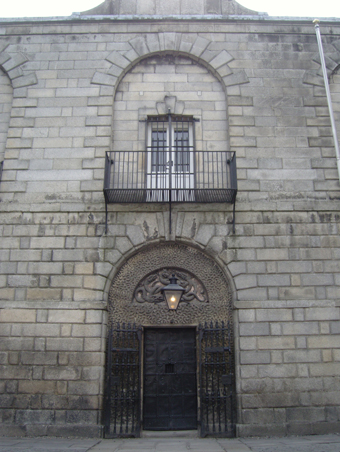 |
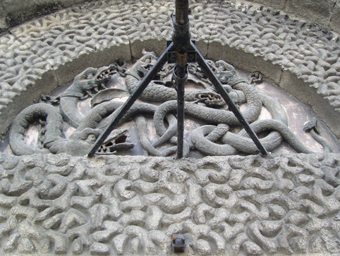
A view of the boldly rusticated and vermiculated doorcase that forms the centre of the entrance block and which features a chained serpent, the mythical hydra, in its overpanel. It is said that the many-headed serpent represented the five worst crimes: murder, piracy, rape, theft and treason. Just visible in the recess overhead are two granite inserts where the gallows used to be attached for public hangings. The last public execution took place in 1865 when Patrick Kilkenny was hanged for the murder of Margaret Waugh |
A view of the boldly rusticated and vermiculated doorcase that forms the centre of the entrance block and which features a chained serpent, the mythical hydra, in its overpanel. It is said that the many-headed serpent represented the five worst crimes: murder, piracy, rape, theft and treason. Just visible in the recess overhead are two granite inserts where the gallows used to be attached for public hangings. The last public execution took place in 1865 when Patrick Kilkenny was hanged for the murder of Margaret Waugh
In classical mythology the killing of the hydra was one of the twelve labours of Hercules. Here it is depicted in chains, thus clearly marking, for those that understood the symbolism, the function of the building, the control of those threatening society. Public hangings were from a gallows directly above the doorway. The combination of the hydra and the hanged no doubt further emphasised this function of control. The austere architectural detailing and classical symbolism were clearly designed to impress and intimidate.
Despite the original intentions the prison soon became overcrowded, with cells built for one often holding multiple prisoners. In 1840 a block of thirty cells was added to the west wing. But no sooner was the block completed than there was a major increase in prisoners arising from the Great Famine. The prison registers for the period show a dramatic increase in imprisonment for food related offences. In times of mass famine a prison diet was a luxury and preferable to starvation. To discourage such prisoners the prison diet was reduced to a minimum.
.jpg)
An extract from the Ordnance Survey published in 1864 showing the effects of the partial reconstruction of Kilmainham Gaol in the early 1860s. Of principal interest is the bow-ended East Wing completed to a design by John McCurdy (c.1824-85), the expanse of which required the annexing of a portion of the grounds of the adjacent Kilmainham Courthouse. Some ground was also taken from Kilmainham Road for the purposes of a walled-in Stonebreakers’ Yard on the north-west and Exercise Yard and Male Hospital on the north-east
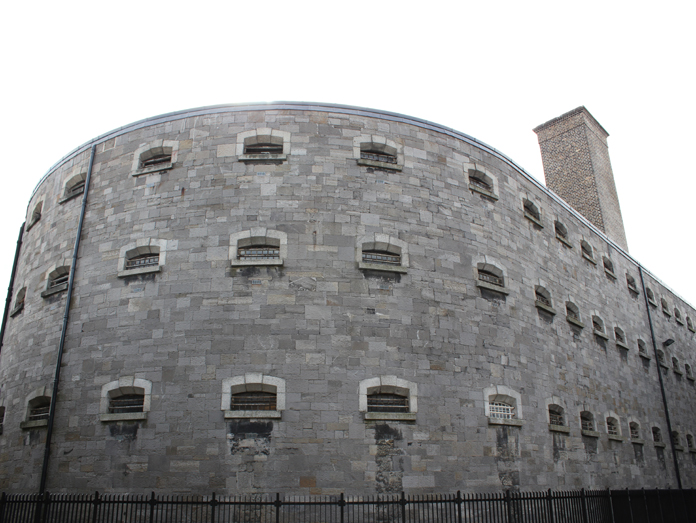
The next major attempt to deal with overcrowding involved the demolition of the old east wing and its replacement in 1861 by a new three storey over basement wing to an award-winning design by John McCurdy (c.1824-85), coincidentally also the architect for the Shelbourne Hotel. This is a classic Victorian prison design organised around the principle of central observation and control, allowing prison staff to have, from a central point, a view of every cell door in the block. The outer wall was moved eastwards to accommodate the new block.
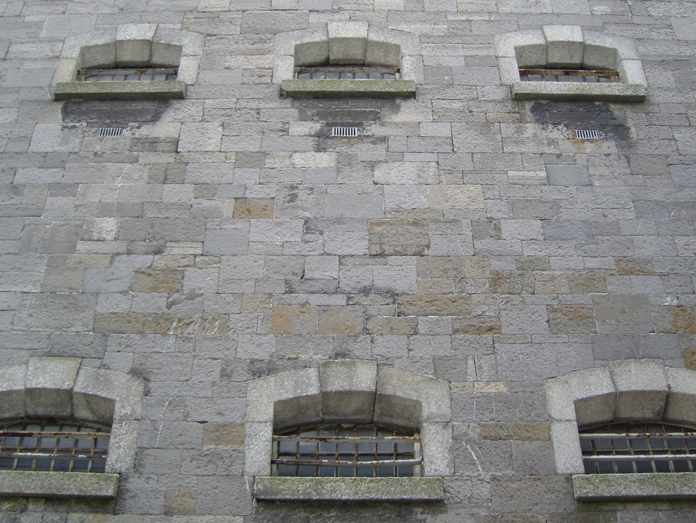
Kilmainham is sometimes described as “Ireland’s Bastille”. It is interesting to contrast the fate of both buildings. The Bastille was deliberately demolished as one of the first events of the French Revolution. Models of the prison, fashioned from the original stones, were carried in religious-like procession to the major cities of France to popularise the success of the revolution. Some of these were later incorporated into new civic buildings, symbolising the building of a new society on the ruins of the old.
.jpg)
James (Séamus) Brennan, Secretary of the Kilmainham Gaol Restoration Committee and a prisoner in Cell 3 in 1916, guides a group of visitors through the ruined East Wing in May 1960. Courtesy of the Office of Public Works
A similar fate threatened Kilmainham – without the processions – until the Kilmainham Gaol Restoration Committee, a voluntary body, was established in 1960 with the objective of restoring and reopening the prison for the fiftieth anniversary of the 1916 Rising. It was officially reopened in 1966 by President De Valera, its last prisoner. The Committee continued to manage the prison until it was handed over to the State in 1986.
The debates in relation to sites such as Kilmainham and the Bastille are not unusual. Very similar issues have arisen about the future of the former Maze Prison in the North, the remains of the Berlin Wall and other similar sites. Should these sites be preserved or demolished? Are they monuments to tyranny or of the fight to overthrow it? Does preserving them glorify acts that now appear unjustifiable? How do you deal with different perspectives of the same site? What Kilmainham does brilliantly today is to present its history with all its contradictions, difficulties and perspectives.
It is difficult to pick out a highlight, but personally I find the exhibition particularly interesting, and one that merits repeated visits. The walls tell the story of the prison as an institution but using the many artefacts donated over the years, the hundreds of personal stories that go to make up what we call history are told.
Look out for the unopened box of chocolates…
Text: Willy Cumming, National Inventory of Architectural Heritage
Photography: Sarah Buckley and Damian Murphy, National Inventory of Architectural Heritage
*****
Kilmainham Gaol is open daily. Click here for visitor information. Among the highlights of the tour are:
KILMAINHAM COURTHOUSE
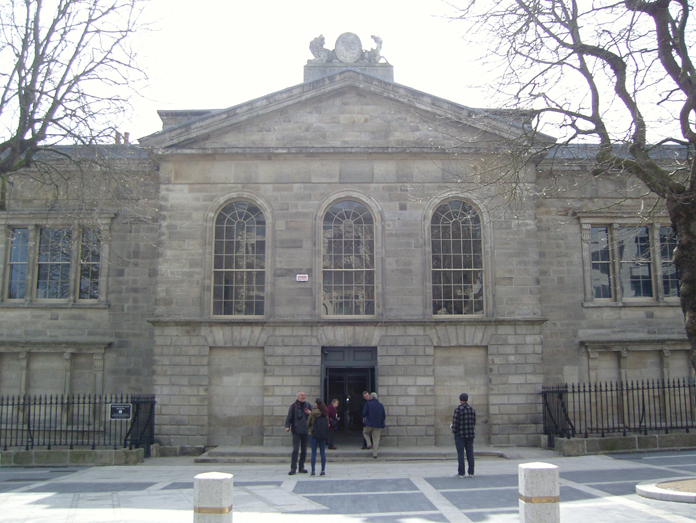
A view of the neo-Classical “sessions house” designed by William Farrell (d. 1851) and opened in 1820. Closed in 2008, the courthouse was given to the Office of Public Works in 2013 in an official ceremony that saw the keys handed over by Mrs. Susan Denham, Chief Justice of Ireland. Following a sensitive restoration, the courthouse reopened on Wednesday, 30th March 2016, as the new visitor centre for Kilmainham Gaol giving visitors an experience of trial by jury before moving on to serve their sentence in the adjacent prison.
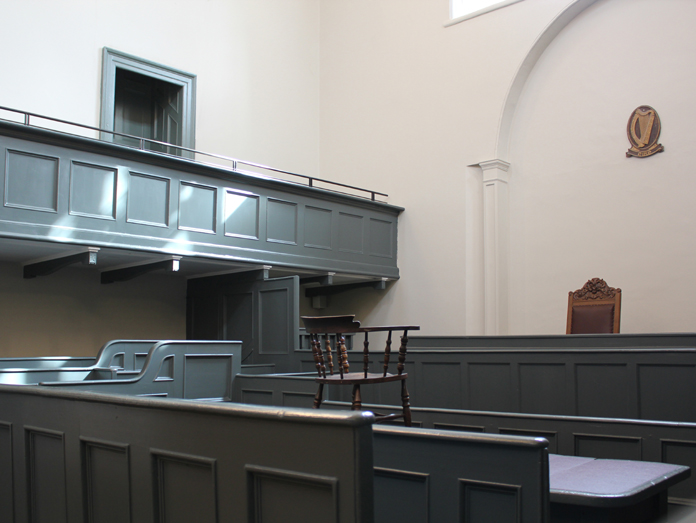
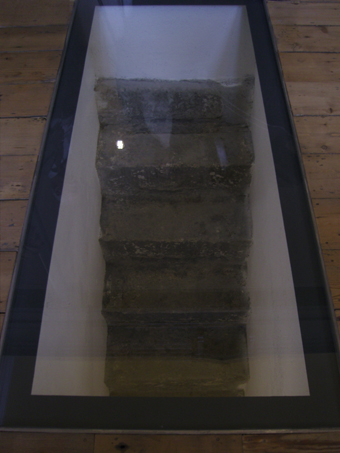
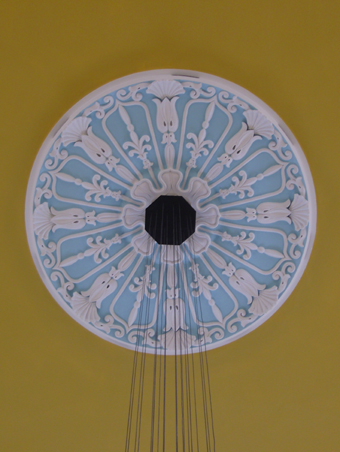
The centrepiece of the restored courthouse is the double-height galleried courtroom with its timber panelled fittings dating from 1865. Visitors will also see a recently uncovered flight of granite steps leading to holding cells in the basement and a decorative plasterwork ceiling rose overhead painted in Wedgewood blue and white.
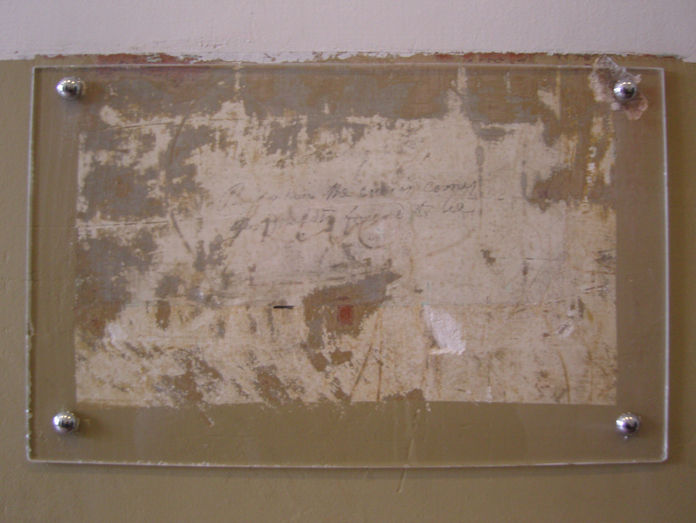
Visitors are free to roam the surrounding corridors where incised graffiti prepares the eye for the wealth of drawings, etchings and inscriptions on the walls of the adjacent prison. More information on the Kilmainham Gaol Graffiti is available here.
THE RED CHAPEL
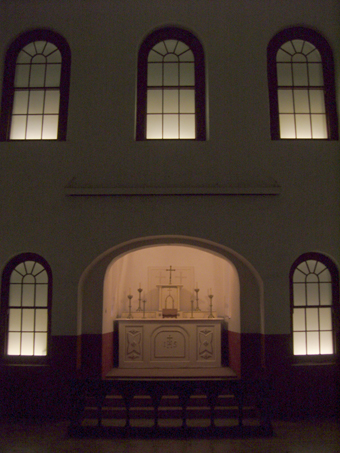 |
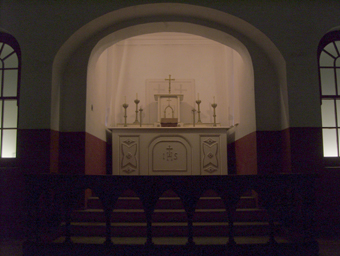
Kilmainham Gaol houses two chapels, one Catholic and one Protestant, the former, the so-called “Red Chapel”, found on the first floor of the central block. The simple timber altar was completed in 1882 by an inmate named James Lalor. The “Red Chapel” was the scene of the eleventh-hour wedding of Joseph Plunkett (1887-1916) and Grace Gifford (1888-1955) in May 1916. Excepting their vows, neither bride nor groom was allowed to speak and Plunkett was led away immediately after the service. He was executed a few hours later. A polished brass plaque records that the “Red Chapel” ‘was restored in 1974 as a result of a generous donation by Áine Nic Lochlainn, Park, Co. Derry, in memory of the patriotic women of Ireland’. |
THE WEST WING
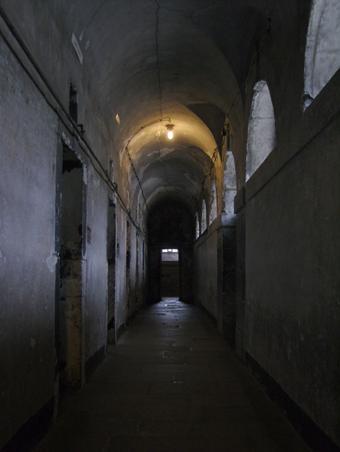
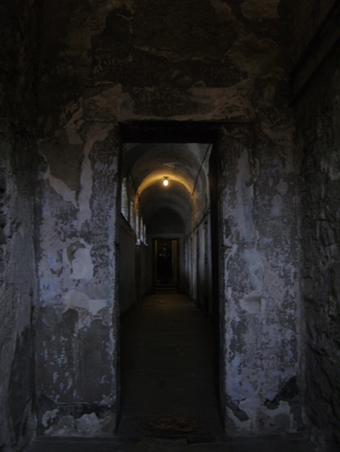
When Kilmainham Gaol first opened in 1796 there were two “U”-shaped wings enclosing courtyards either side of a central block. Only the West Wing survives today. In contrast to the rebuilt East Wing this part of the prison is dank and dark. The cells, designed to hold one inmate, were frequently overcrowded and some prisoners were forced to sleep in the corridors outside. The unglazed lunette window openings overhead were exposed to the elements which, combined with meagre food rations, made for a pitiable existence that discouraged reoffending. Although most famous for its 1916 inmates, the West Wing held earlier generations of political prisoners including members of the United Irishmen following the 1798 and 1803 Rebellions.
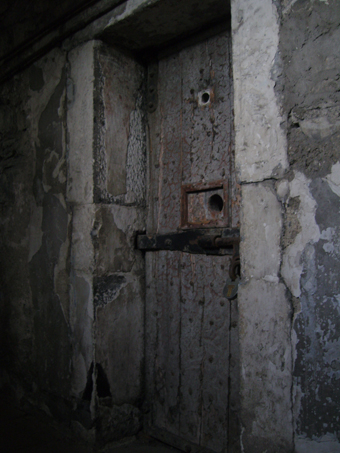
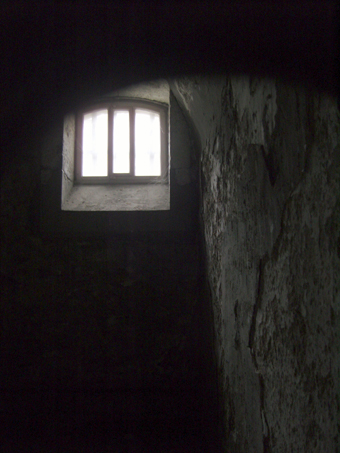
1916 CORRIDOR
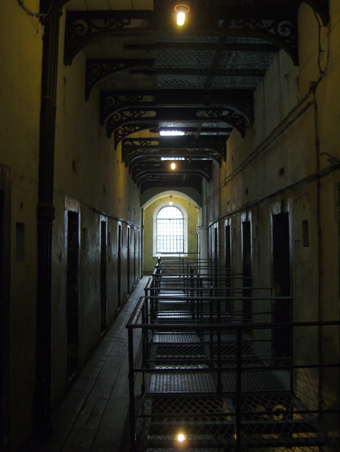
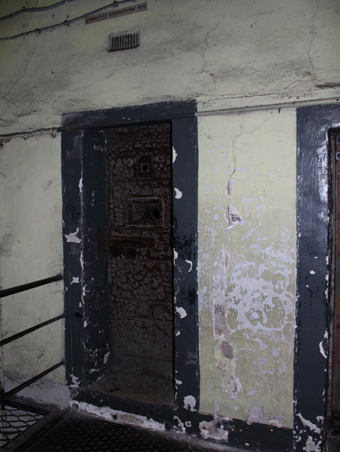
A view of the so-called “1916 Corridor” where some of the leaders of the 1916 Rising were held prior to their execution in the Stonebreakers’ Yard. Name plates record the occupant of each cell including Patrick Pearse (1879-1916) and William “Willie” Pearse (1881-1916); Thomas Clarke (1858-1916); Thomas MacDonagh (1878-1916); Michael Mallin (1874-1916) and Joseph Plunkett (1887-1916). Pictured is the door of the cell belonging to Countess Constance Markievicz (1868-1927) who was originally sentenced to death but whose sentence was subsequently commuted to life in prison.
THE EAST WING
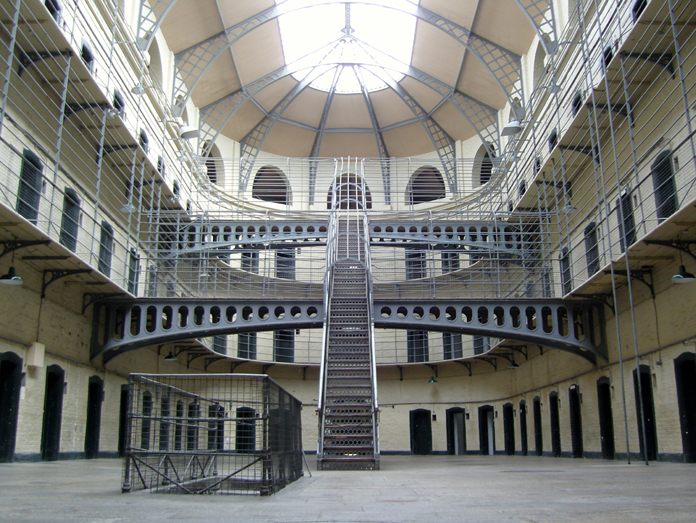
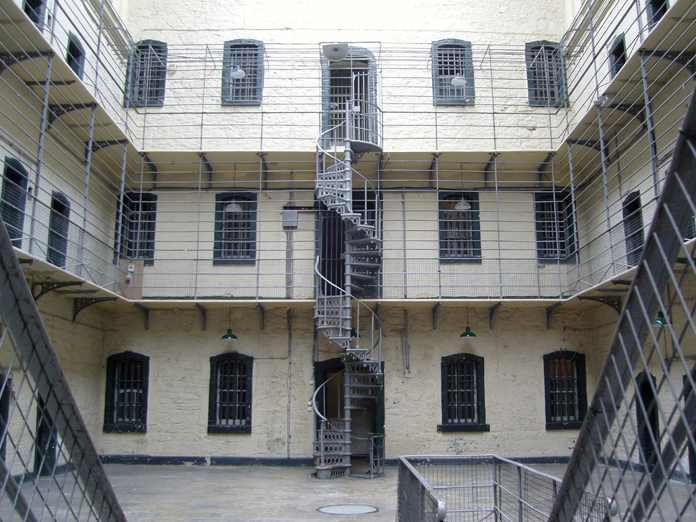
The new East Wing, built to a design by John McCurdy (c.1824-85), reflected the new ideals of Victorian prison theory and was modelled on the Panopticon developed by the philosopher and social reformer Jeremy Bentham (1747-1832) in the late eighteenth century. Each of the ninety-six cells is visible from a single vantage point on a central platform. Communication between inmates was forbidden and they spent much of their time in solitary confinement in their cells. Meals were delivered to each of the three tiers via a pulley system while movement was restricted by numerous devices including a spiral staircase intended to prevent a charge by prisoners in the unlikely event that they managed to escape their cells.
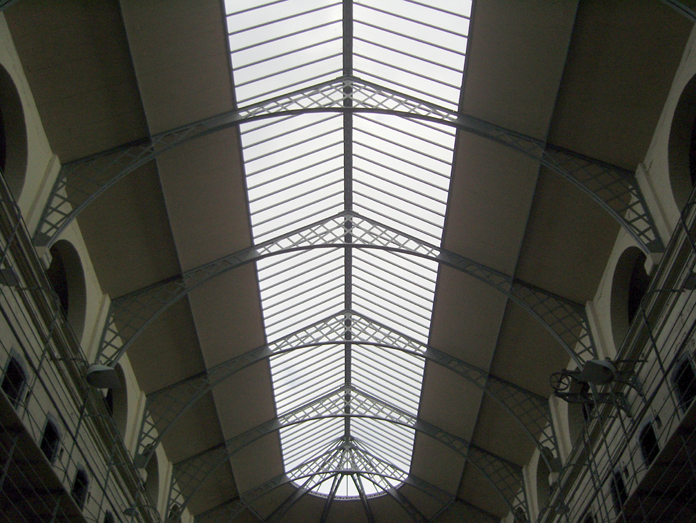
In contrast to the claustrophobic West Wing where the female prisoners remained, the new East Wing was comparatively airy with a long lantern filling the central core with cleansing rays of sunlight. The lantern has recently been restored to its original form by the Office of Public Works
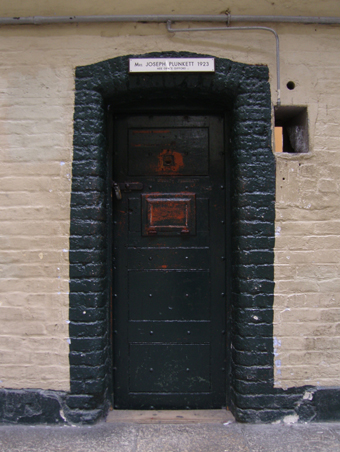
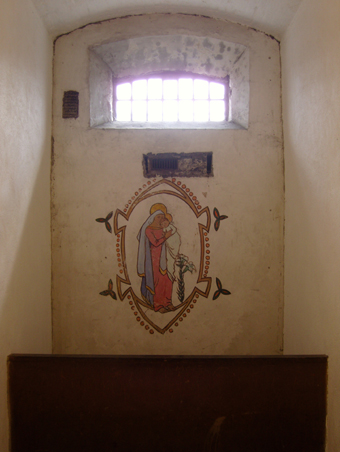
Visitors to Kilmainham Gaol will see name plates over many of the cell doors recording political prisoners who fought for an Irish Republic. One such plate carries the name of Mrs. Joseph Plunkett, née Grace Gifford, who was interned for three months in 1923 during the Civil War. The Madonna and Child on the back wall of the cell is not by Grace herself, however, her original crayon drawing having deteriorated when Kilmainham Gaol fell into ruin following its closure in 1924. A faithful facsimile in oil was completed on the replastered wall by Tom Ryan RHA. Other doors in the East Wing carry the names given to individual cells by prisoners and include an example inscribed “DUNMORE”
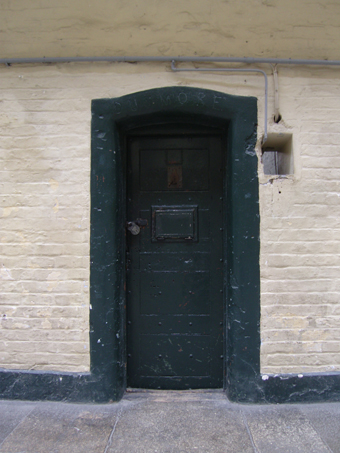
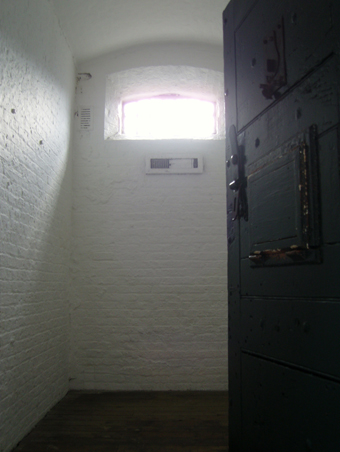
STONEBREAKERS’ YARD
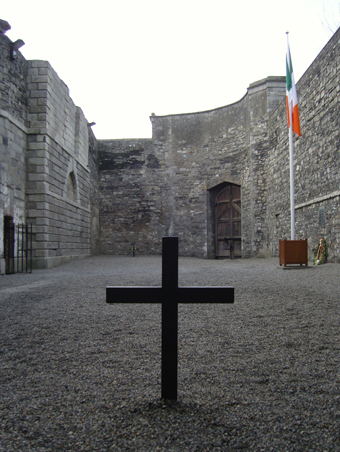
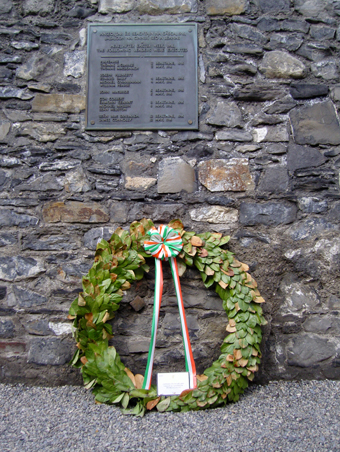
The plan on the Ordnance Survey published in 1864 reveals a system of yards including Exercise Yards and segregated yards intended for Master Debtors, Pauper Debtors, Females and Female Debtors. All prisoners were allocated one hour of outdoor activity per day. The most famous yard, unnamed on the plan, is the Stonebreakers’ Yard where men sentenced to hard labour would work out their time manually breaking up stones. It was in the Stonebreakers’ Yard that fourteen leaders of the 1916 Rising were executed by firing squad. A simple cross marks the spot where thirteen of the leaders stood while a corresponding cross in the background marks the spot where the injured James Connolly (1868-1916), carried into the yard on a stretcher, was tied to a chair and executed. A central panel records the names of the leaders and their date of execution and is pictured here with the wreath laid by President Michael D. Higgins on Easter Monday 2016
THE PROCLAMATION
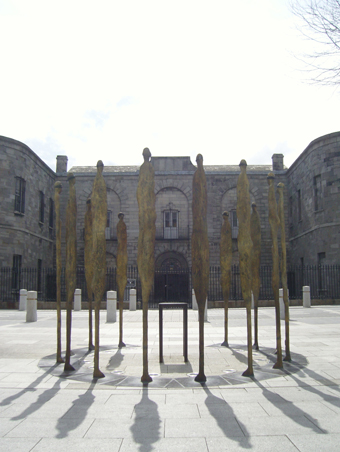 |
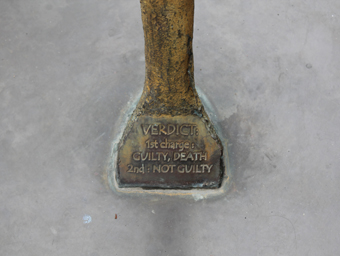
On leaving Kilmainham Gaol the visitor will see The Proclamation (2007), a monument dedicated to the executed leaders of the 1916 Rising created by the Dublin-born sculptor Rowan Fergus Meredith Gillespie (b. 1953). Fourteen blindfolded figures are arranged in a megalithic circle at the centre of which is a copy of the Proclamation of the Irish Republic. The figures are perforated with bullet holes. At the foot of each figure is a panel embossed with their verdict and sentence to death. Gillespie’s grandfather was James Creed Meredith K.C. LL.D. (1875-1942), Judge of the Supreme Court of Ireland and a steadfast pacifist. Gillespie’s Proclamation was created in memory of both the Proclamation of the Irish Republic and of his grandfather’s dream of a Utopian society |
FURTHER READING
Cooke, Pat, A History of Kilmainham Gaol 1796-1924 (Dublin: Dublin Stationary Office, 1995)
O’Dwyer, Rory, “The Wilderness Years: Kilmainham Gaol 1924-1960” in History Ireland (Nov/Dec 2010)
O’Dwyer, Rory, The Bastille of Ireland (Dublin: History Press Ireland, 2010)
Lüsebrink, Hans-Jürgen and Reichardt, Rolf, The Bastille: A History of a Symbol of Despotism and Freedom (Durham: Duke University Press, 1997)
